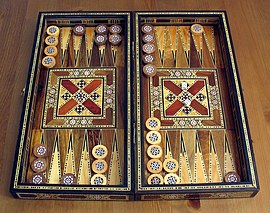Tavli
|
A backgammon board from Damascus
|
|
| Players | 2 (more in some variants) |
|---|---|
| Setup time | 0–30 seconds |
| Playing time | 5–30 minutes |
| Random chance | Dice |
| Skill(s) required | Strategy, Probability |
Tables is a general name given to a class of board games similar to backgammon, played on a board with two rows of 12 vertical markings called "points". Players roll dice to determine the movement of pieces. Tables games are among the oldest known board games, and many variants are played throughout the world.
The ancient Egyptians played a game called Senet, which belonged to the same family of "race games" as modern tables games, with moves controlled by the roll of dice as early as 3500 BC. The Royal Game of Ur, played in ancient Mesopotamia, is another member of the family. Recent excavations at the "Burnt City" in Iran showed that a similar game existed there around 3000 BC. The artifacts include two dice and 60 pieces. The set is believed to be 100 to 200 years older than the sets found in Ur. Though they are all race games they cannot be direct ancestors of backgammon.
Roman Tabula (Byzantine Greek: Tάβλη) was nearly identical to modern backgammon; it was described in an epigram of the Byzantine Emperor Zeno (AD 476–481). The board was the same with 24 points, 12 on each side, players moved their pieces in opposite directions, and the dice were cubes as today. As in backgammon the object of the game was to be the first to bear off all of one's checkers, of which there were, as in backgammon, fifteen per player. Hitting a blot, reentering a piece from the bar, and bearing off, all had the same rules as today. The chief differences with modern backgammon were the use of three rather than two dice, the starting of all pieces off the board (with them entering in the same way that pieces on the bar enter in modern backgammon), and naturally no doubling cube (which was introduced in the 1920s). The same word (τάβλη) is still used to refer to backgammon in Greece today, where it remains a popular game played in central village squares (plateias) and coffee houses.
...
Wikipedia

